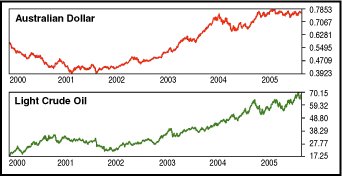Access to foreign exchange trading has opened up exciting trading options for the retail trader. You can now trade alongside corporations and institutions in a highly liquid market that is global, traded around the clock, and highly leveraged. Before jumping into this market, however, we must understand the factors that affect the forex market. With that in mind, STOCKS& COMMODITIES has introduced Forex Focus to better prepare the retail trader to participate in the currency market.
Is The Aussie A Leading Indicator?
by Darrell Jobman
Down under may be over the top. If you doubt it, then what's it mean when commodities trend down when the Australian dollar weakens against the US dollar?
To a large extent, fundamental analysis involves extrapolating the future from the events of the past as analysts review historical numbers in search of identifiable trends. Traditional technical analysis suffers from the same backward-looking drawback when it relies on traditional moving averages, arcane chart patterns, and a variety of measurements to indicate when or if a market or security has become overbought or oversold.
The purpose of investing, however, is not to identify what has happened but rather to anticipate what is likely to happen. One of the best ways to look and think forward comes from studying how the trend of one market affects another. Most often, this is called intermarket analysis.
As capital flows from one long-term theme to the next, it typically shifts its geographical emphasis. In recent years, money has poured into Asia in search of superior investment returns and out again with almost single-minded ferocity. In 1998, capital outflows from countries such as Singapore, Thailand, Indonesia, the Philippines, and Malaysia helped create a financial markets crisis that spilled over to Russia and then Brazil. Capital continued to flow into the US dollar to help finance the tech bubble that eventually began to collapse in 2000 before turning toward Europe to take advantage of higher real interest rates.
CURRENCIES ARE KEY
In many respects, currencies act as both gateways and signposts for ongoing macro trends. When a currency is appreciating relative to other major currencies, it shows which direction capital is moving toward and, perhaps just as important, which direction it is moving away from.
From an intermarket perspective, the trend of the Australian dollar against a host of other currencies is often quite instructive. The Australian dollar is one of the "commodity currencies" (along with the Canadian dollar, New Zealand dollar, and often the South African rand) because it tends to move higher or lower in tandem with or ahead of commodity prices.
The key is that a long-term rising trend for commodity prices will typically coincide with, or even be led by, appreciation in the Australian dollar relative to the US greenback. A reversal lower and subsequent weakness in this currency will serve as an early indication that the bull market for commodity prices may be coming to an end.

FIGURE 1: THE LEADING AUSSIE. From 2002 to 2005 the Australian dollar relative to the US dollar trended higher. Note that crude oil prices followed that trend.
Originally published in the January 2006 issue of Technical Analysis of STOCKS & COMMODITIES magazine. All rights reserved. © Copyright 2005, Technical Analysis, Inc.
Return to January 2006 Contents